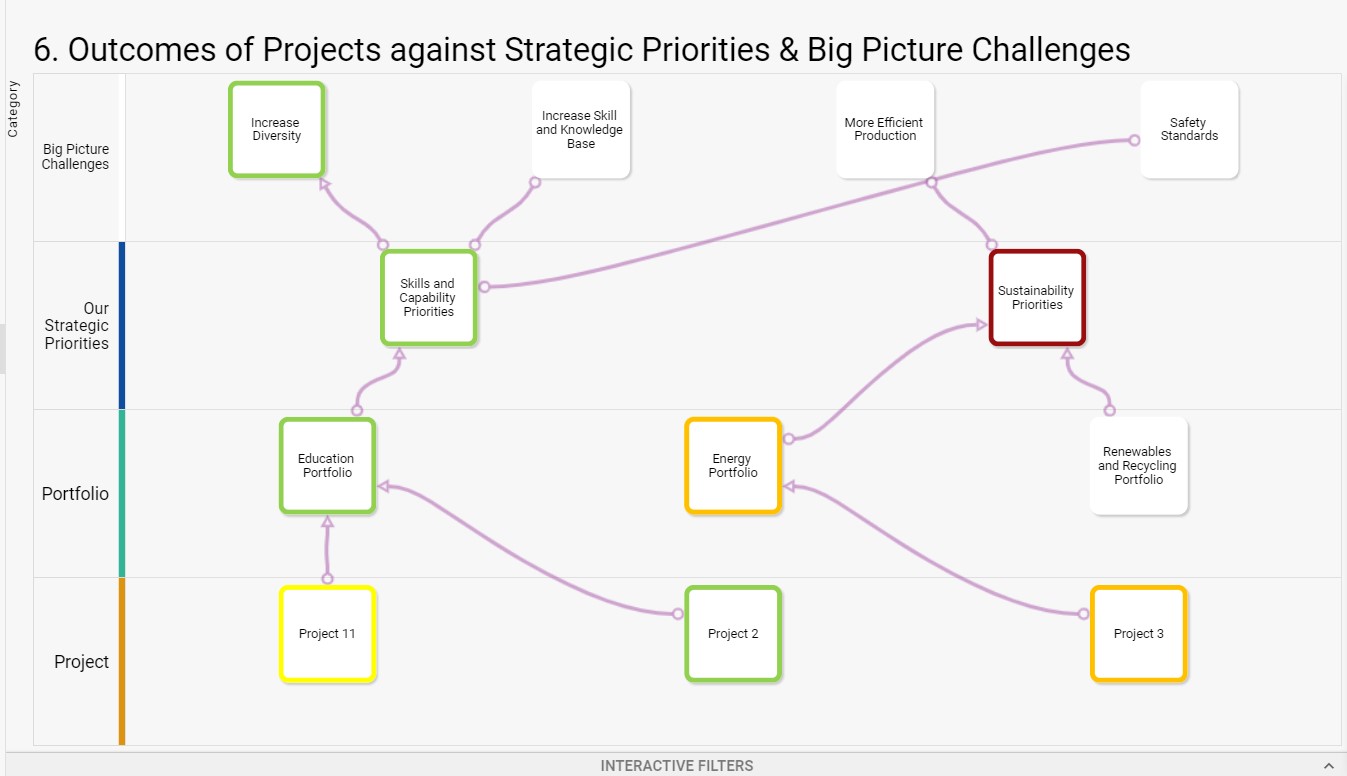In the ever-evolving landscape of business, organizations face the constant challenge of determining where to focus their resources and efforts. Strategic prioritization plays a crucial role in charting a path towards success. It involves the deliberate process of identifying and ranking your strategic priorities to ensure alignment with the organization's vision, goals, and long-term success. In this blog, we will explore the significance of strategic prioritization and provide insights into how it can drive organizational success.
We will focus on four key areas: Innovation and Research & Development (R&D), Business Growth and Market Expansion, Sustainability/ESG, and Digitalization. By effectively prioritizing and aligning these areas, organizations can enhance their competitive advantage and navigate the complexities of today's business environment.
What is Strategic Prioritization?
Strategic prioritization is the the deliberate process of identifying and ranking priorities to ensure alignment with the organization's vision, goals, and long-term success.
According to a Harvard Business Review article, the payoff for prioritization is impressive, “Prioritizing increases the success rates of strategic projects, increases the alignment and focus of senior management teams around strategic goals, clears all doubts for the operational teams when faced with decisions, and, most important, builds an execution mindset and culture.”
Setting Clear Objectives
Strategic prioritization starts with setting clear objectives that are aligned with the organization's mission and vision. These objectives serve as the guiding principles for decision-making and resource allocation. By defining specific, measurable, achievable, relevant, and time-bound (SMART) goals, organizations can identify the areas that require the most attention and prioritize accordingly. Clear objectives provide a sense of direction and ensure that everyone within the organization is working towards a common purpose.
Evaluating and Ranking Initiatives
Once objectives are established, organizations must evaluate and rank various initiatives based on their alignment with the objectives, potential impact, feasibility, and available resources. This evaluation process helps identify the initiatives that will deliver the highest value and contribute the most to the organization's success. By considering factors such as strategic fit, market opportunities, competitive advantage, and risks, organizations can make informed decisions on which initiatives to prioritize.
- How are you effectively visualizing your business and its various layers to make informed decisions about which initiatives to prioritize?
Resource Allocation
Strategic prioritization involves allocating resources, including financial, human, and technological, to the initiatives that have been prioritized. Resources are limited, and effective prioritization ensures that they are utilized in the most efficient and effective manner.
By aligning resources with the selected initiatives, organizations can optimize their utilization, avoid spreading resources too thin, and focus on initiatives that have the greatest potential for success. Regular monitoring and adjustment of resource allocation are essential to maintain alignment with changing priorities and market conditions.
Adapting to Change
Strategic prioritization is not a one-time exercise but an ongoing process that requires adaptability and agility. External factors, such as market dynamics, customer preferences, and technological advancements, may change over time. Organizational priorities must be flexible and responsive to these changes. Regular reassessment of priorities and realignment of initiatives is crucial to ensure that the organization remains proactive and maintains a competitive edge in the marketplace.
Effective Communication and Alignment
Strategic prioritization is a collaborative effort that requires effective communication and alignment across all levels of the organization. Clear and transparent communication of priorities ensures that all team members understand the rationale behind the selected initiatives and can align their efforts accordingly.

This alignment fosters a shared sense of purpose and empowers employees to make decisions and take actions that support the strategic priorities. Regular communication and feedback loops are essential to ensure that everyone remains informed and engaged throughout the prioritization process.
Innovation and Research & Development (R&D)
Innovation is the lifeblood of any organization, driving its ability to stay ahead of the competition. Strategic prioritization of innovation and R&D involves investing resources and talent into developing new products, services, or processes. By fostering a culture of creativity, experimentation, and continuous improvement, organizations can fuel breakthrough ideas and drive sustainable growth. Prioritizing innovation ensures that the organization remains adaptable, customer-centric, and at the forefront of industry trends.
However according to McKinsey
"Many enterprises lack an R&D strategy that has the necessary clarity, agility, and conviction to realize the organization’s aspirations. Instead of serving as the company’s innovation engine, R&D ends up isolated from corporate priorities, disconnected from market developments, and out of sync with the speed of business.
Companies wishing to get ahead and stay ahead of competitors need a robust R&D strategy that makes the most of their innovation investments. Building such a strategy takes three steps: understanding the challenges that often work as barriers to R&D success, choosing the right ingredients for your strategy, and then pressure testing it before enacting it."
Business Growth and Market Expansion
Strategic prioritization of business growth and market expansion involves identifying and pursuing opportunities that can drive revenue and expand the organization's reach. This includes exploring new markets, targeting untapped customer segments, or diversifying product/service offerings.
By conducting market research, analyzing consumer trends, and leveraging competitive intelligence, organizations can make informed decisions about where to allocate resources to achieve sustainable growth. Prioritizing business growth enables organizations to seize opportunities, build market share, and increase profitability.
Sustainability/ESG
In recent years, sustainability and Environmental, Social, and Governance (ESG) factors have gained significant importance in the business landscape. Strategic prioritization of sustainability and ESG involves integrating responsible practices into the organization's operations, supply chain, and corporate culture.
By prioritizing sustainability initiatives, organizations can reduce their environmental impact, enhance their brand reputation, attract socially conscious customers, and foster employee engagement. Additionally, integrating ESG considerations into decision-making processes can mitigate risks, ensure long-term viability, and create value for all stakeholders.
Digitalization
Digitalization has transformed industries and revolutionized the way businesses operate. Strategic prioritization of digitalization involves harnessing the power of technology to enhance operational efficiency, improve customer experience, and drive innovation.
This includes adopting digital tools and platforms, leveraging data analytics for informed decision-making, and embracing automation and artificial intelligence. By prioritizing digital transformation, organizations can streamline processes, optimize resource allocation, and stay agile in an increasingly digitized marketplace.
The Synergy of Prioritization
While each area—innovation, business growth, sustainability/ESG, and digitalization—has its unique importance, the real power lies in their synergy. Strategic prioritization involves identifying the interdependencies between these areas and ensuring they are aligned with the organization's overall vision and objectives.
For example, innovation can drive sustainability through the development of eco-friendly products or processes. Digitalization can enable business growth by providing data-driven insights for targeted market expansion. Integrating sustainability and ESG principles can enhance innovation and digital transformation by aligning them with social and environmental needs.
Understanding the interplay between these areas and aligning them with the organization's vision will enable businesses to thrive in a world driven by innovation, responsible practices, and digital transformation.
Conclusion
Strategic prioritization is vital for organizations seeking sustained success in today's rapidly changing business landscape. By setting clear objectives, evaluating and ranking initiatives, allocating resources effectively, adapting to change, and fostering alignment, organizations can navigate the complexities of the business landscape and drive sustainable success.
Strategic prioritization empowers organizations to focus on the initiatives - such as innovation and R&D, business growth and market expansion, sustainability/ESG, and digitalization - that will have the greatest impact and deliver long-term value, ensuring that every effort contributes to the realization of the organization's vision and goals.
